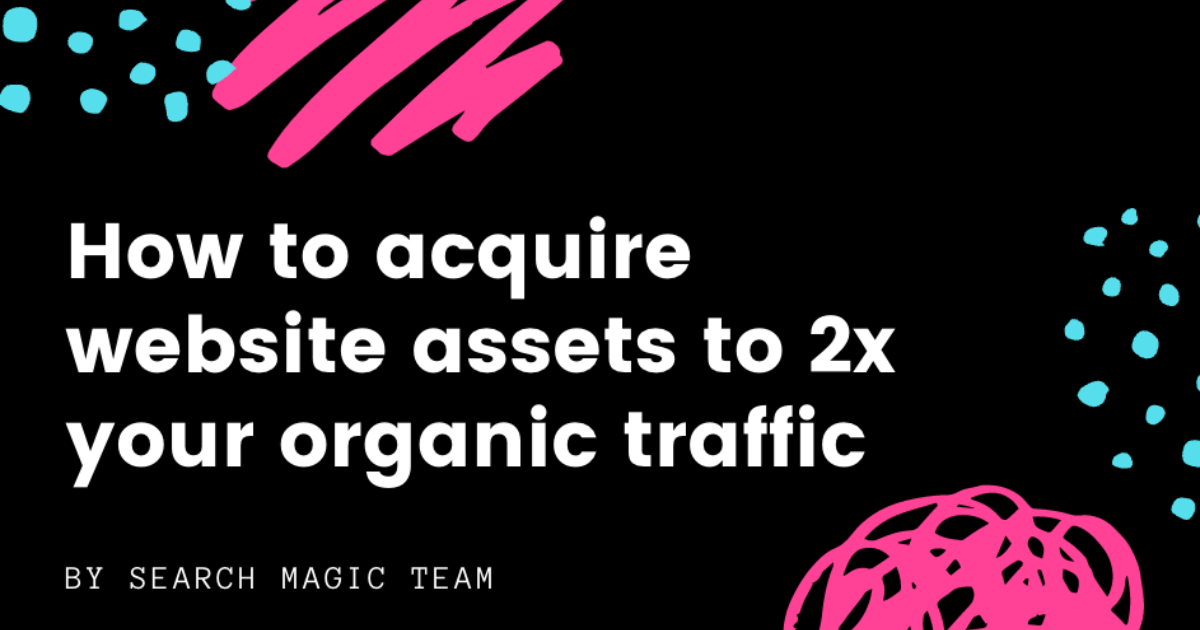We all know pretty much how SEO works, which is keywords, optimise the pages for the keywords, create content, build backlinks, and wait and then create more content, build more backlinks, and wait. But sometimes the process got stuck because the keywords we chose are too competitive and they are too competitive, because they have a huge amount of searches. Or they just have huge competition on top search results. We all know these 10 or 20 keywords that we want our business to be found for. They are the keywords that they are really related to our business, and they are the keywords also that they may have a huge potential of traffic, but the effort is too hard.
Let’s take the example of an eCommerce store
Let’s take the example of an ecommerce pharmacy store that sells food supplements.
One of their core keywords might be online pharmacy or vitamin D supplement.
These keywords have a huge commercial potential, and they can bring traffic and sales to the website, and they also have a huge amount of searches. They have around 2000 to 30,000 searches per month, it’s a big thing.
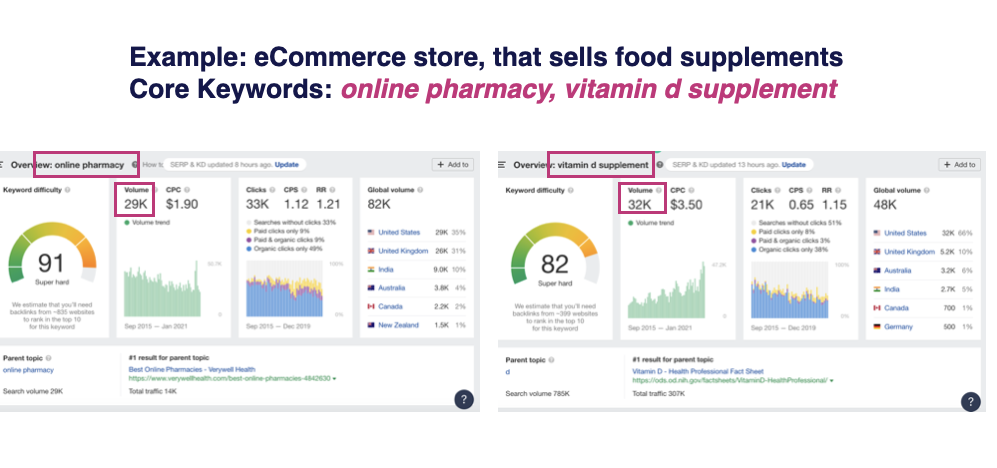
Assuming that we are not Amazon, and we don’t have Amazon resources. To get in the top search results for these terms, we will need to:
- create around 100 to 200 pieces of content and
- build 400 to 500 backlinks
Τhis process will probably take one-year and maybe more than that, a huge amount of time and a huge amount of resources.
But, there is another way to get there without all this pain. Of course, you have to follow the SEO process and create content, build backlinks and everything. But this technique is about to save you a tone of time.
Buying website assets and utilize them to boost your rankings.
It’s the technique of buying domains and utilise their content or their authority to boost your rankings.
So, this is a real graph from a real Google Analytics account that shows the organic growth of a website in just three months after acquiring only one website asset.

So, this is a really good strategy to follow, if you want a quickly, topical relevance and immediate injection of traffic to your website.
There are two motives behind the website acquisition
- Content
- Authority.
Let’s dive into it! ????
**Note: I will keep as a main example the ecommerce pharmacy store that sells food supplements
Content – Motivated Purchase
Now let’s see a content motivated purchase example.
Let’s say that we want to acquire a wellbeing blog with 1000 articles.
We made an audit, and we find out that we can utilise 500 articles that they already ranking top search results for keywords such as vitamin D, vitamin D supplements, magnesium, online pharmacies, and keywords like that.
If we actually do purchase this website, what we just achieved is that :
- We just bought the rankings for the most important keywords that we want to rank for because we buy the content that rank for these keywords.
- We’re getting immediate injection of traffic assuming that this website has already traffic,
- We quickly add topical relevance for the topic of supplements that will allow us to rank higher for a multiple set of keywords and
- We skip or even limit the content marketing process because you just bought 500 articles.
Authority – Motivated Purchase
Now let’s see an authority motivated purchase example.
Let’s say that we want to acquire a healthy lifestyle blog that has higher authority than our own website and of course higher Domain Rating.
Assuming that we’ve already checked the backlinks, and it has a healthy backlink profile, it’s a good choice to move on with.
So, if we do buy this domain, what we achieved is that:
- We get relevant backlinks for our own website that will allow us to rank higher for multiple keywords.
- We boost the Domain Rating and the overall authority of our own website,
- We get an immediate injection of traffic assuming that this website has already traffic.
Finding the “Sweet” spot
Of course, having a website that has both usable content and quality backlinks, it’s the best case scenario.
But it’s really rare to find.
So, you might wonder is this strategy can only be applied in ecommerce stores?
Good news is, this is a technique that can be applied in all kinds of industries and all sizes of companies.
One of the reasons behind, is the cost of a website asset could be from $100 to 1000$, or even more, depending on the budget of the company.
But this is not only an SEO decision, this is also a business decision as well, because you are about to acquire a website that has a lot of monetization ways. It might have a community, or being a part of an affiliate network.
So, you also buy another revenue stream, you buy another business, and you buy a website that you can monetize with a lot of different ways.

Now, let’s see the end-to-end process of how to acquire website assets.
The process is split into three phases.
- Pre acquisition Phase
- Acquisition Phase
- Post acquisition phase.
The hardest work must be done in the post acquisition phase, but we will see everything in detail and how to do it step by step.
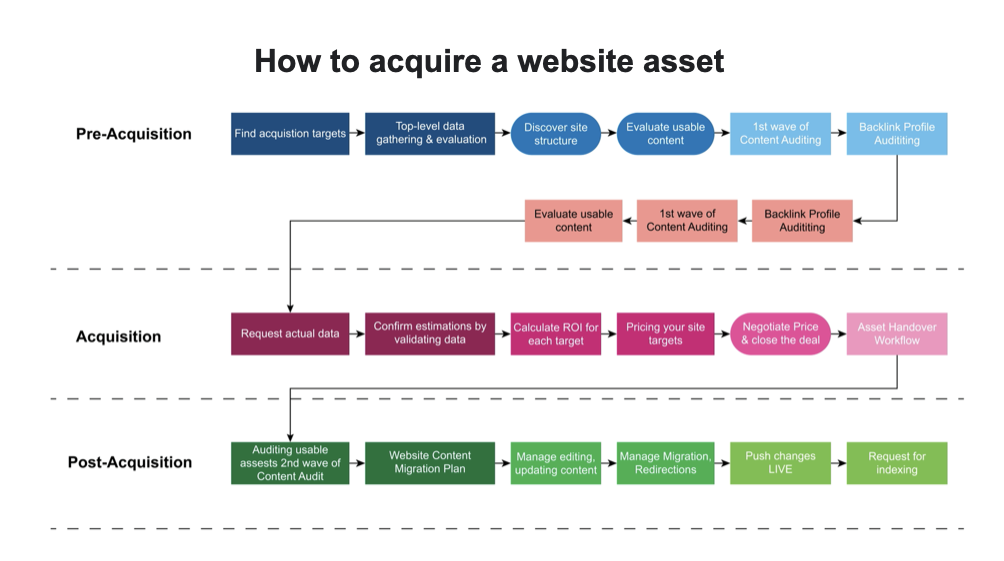
1. Pre-acquisition Phase
In the pre acquisition phase, the goal is to do a top-level data gathering and the first auditing of content and backlinks and of course, estimate the revenue and the costs of your website targets. So how do you find website as opportunities?
There are three ways to do it.
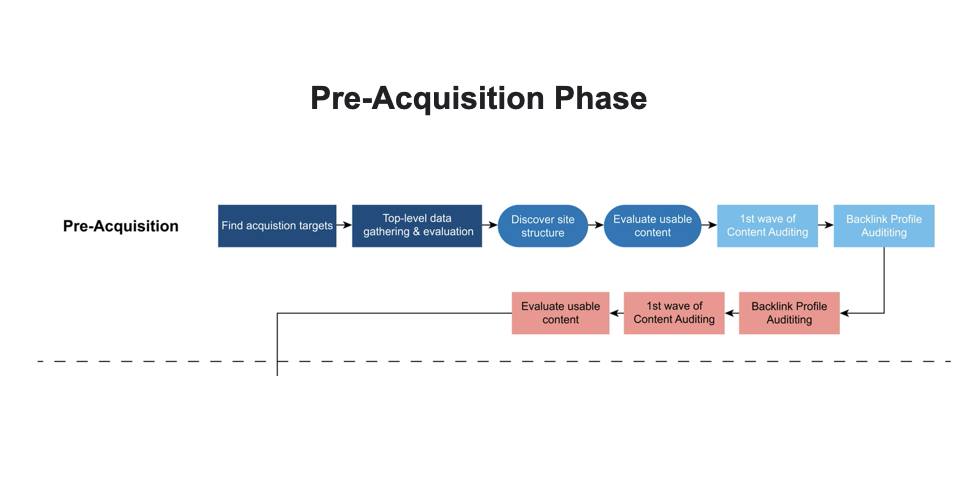
By doing keyword research and finding interesting domains in the search results.
By searching broken links, you could start from your competition.
By visiting auction sites, and I’m not talking about expired domains.
You can visit either flippa.com or investors.com and find up to 1000s of lists of website assets and find all the details that you need to know the cost per asset, the monetization type, the potential traffic, and other interesting insights.
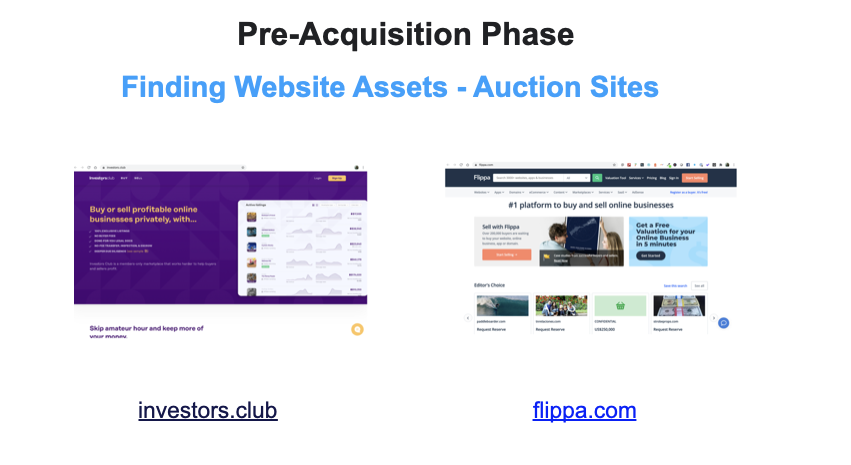
Then you have to move on and do a top level data gathering can define the most important information that are:
- how many are the usable pages
- the potential of the search volume and the traffic
- the potential of the backlinks
Then you will be able to do a rough estimation of the value of this domain.
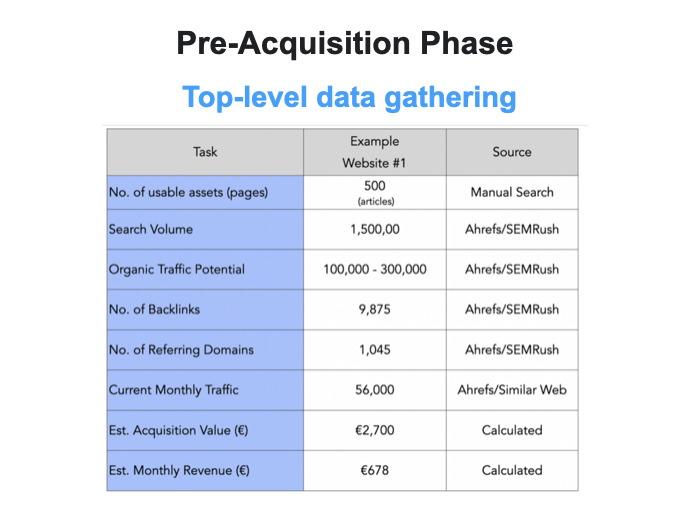
After that, you need to discover the site structure of the website, this is a really important step.
You can start from sitemap or by crawling the website with a tool like Screaming Frog or sitebulb.
Important Note: You need to discover and exclude all the relevant URL paths from your link process because they will be useless after acquiring the website and you don’t want to have wrong numbers about the traffic and the revenue right.
Then, you have to evaluate the content, like a rough auditing and try to determine the relevant content and classify the content in content groups that would make it easier for you after the purchase to make the auditing process and the editing process.
Moving forward with the backlink profile auditing make sure that there is nothing toxic on the website, or there’s nothing that could indicate a spammy website.
Last but not least, you have to estimate the revenue. Here a big role plays the nice that would affect the type of the monetization of the website, affiliate ads and everything that we mentioned before.
The last thing you need to do here is to avoid the cost of buying a domain vs building a domain.
So, you can use these cards in order to define the costs. The criteria are really simple and it’s all about the cost per page per condom piece creation and per backlink and how much time you need to get traffic from this website. Either you build it or either you buy it
In the most cases, it’s more cost efficient to buy the website instead of trying to build the website because of the cost to acquire backlinks and the cost of the content marketing process.

2. Acquisition Phase
Moving forward to the acquisition phase, the goal is to confirm the estimation that you made earlier and negotiate the price and close the deal.
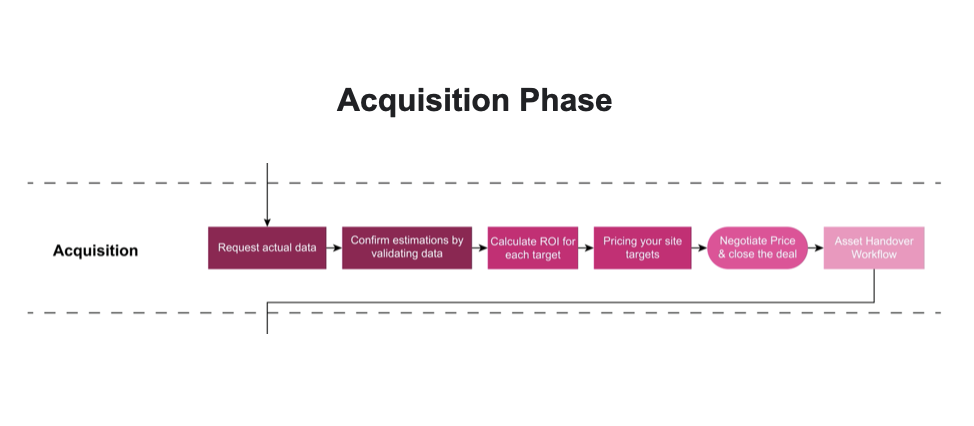
So, the first thing that you need to do at this point is to reach out the owner of the website and request the actual data of the website.
In order to make it easier, you can offer to sign an NDA and ask access to the Google Analytics Google search console platforms to get the actual data.
For the revenue data, you can ask access to stripe data. Don’t forget to ask only what you need. Because the more data that you have the way difficult it became to evaluate the website.
Then it’s time to confirm the estimations that you made in terms of traffic, keyword rankings, content quality, and backlinks and compare all the website assets that you found. It’s highly recommended to create a scorecard that you will use the following criteria.
- How aligned is the topical relevance to your own business
- The rankings of the website
- What’s the trend of the traffic
- How quickly you can get results and the age of the website.
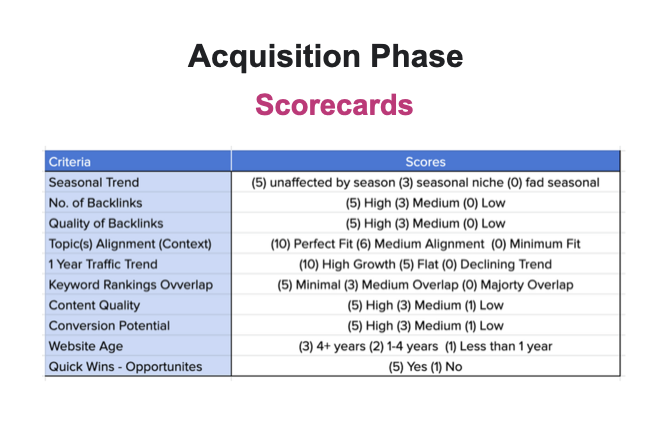
Once you evaluate their website targets with the actual data, you can use these criteria listed to compare one website assets with the other.
So, you can have a solid conclusion on what website asset, you should move forward with. Once you are done with the comparison, you have to do the pricing of its target and decide what it’s the price that you want to pay for its website asset based on the data you have.
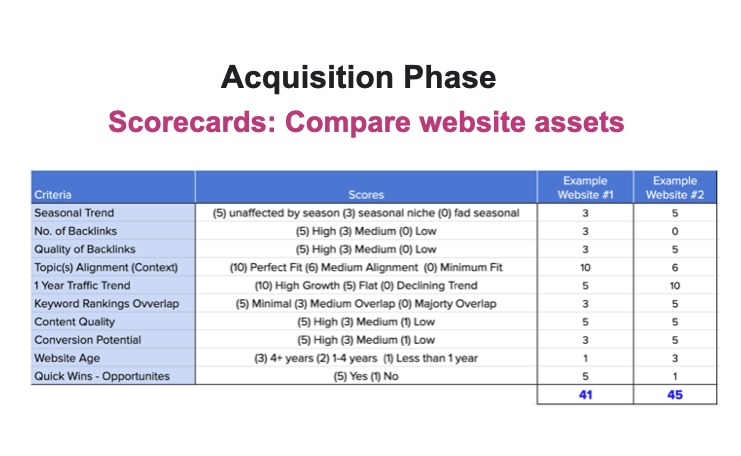
Then you have to reach out again the website owner and negotiate price.
Don’t forget to be really quick and if you can find them by mail, get them on the phone.
When the purchase is done, you have to manage the handover workflow, which needs to be done carefully.
Here’s a quick checklist of the things that you shouldn’t forget to mention when you do the handover.
- Ask the domain name transfer,
- Access to CMS,
- Full access to Google Analytics, Google Tag Manager and Google Search Console. d. Ask they were posting details,
- Ask the handover of all the social media accounts or email marketing platforms, plugins, or any other licences and
- Never forget to ask for image licences or and proof of permissions.
This is really tricky because it’s about personal data and copyrights. So, you need to have the proof of the images licence, because when you acquire the website, any images used without permission becomes your problem.
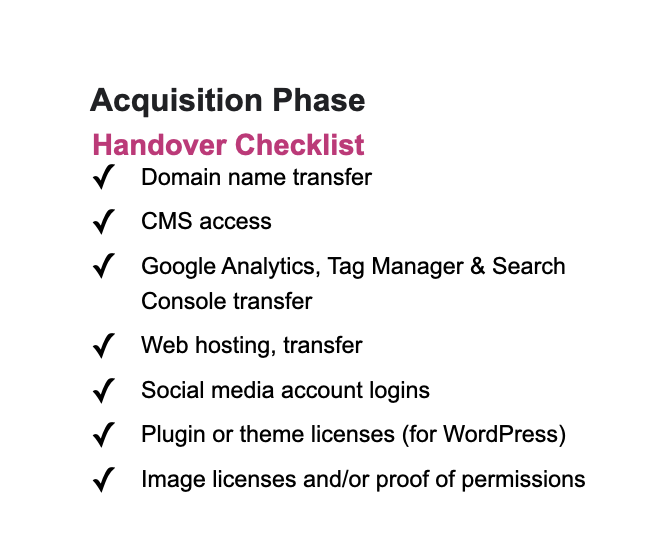
3. Post-Acquisition Phase
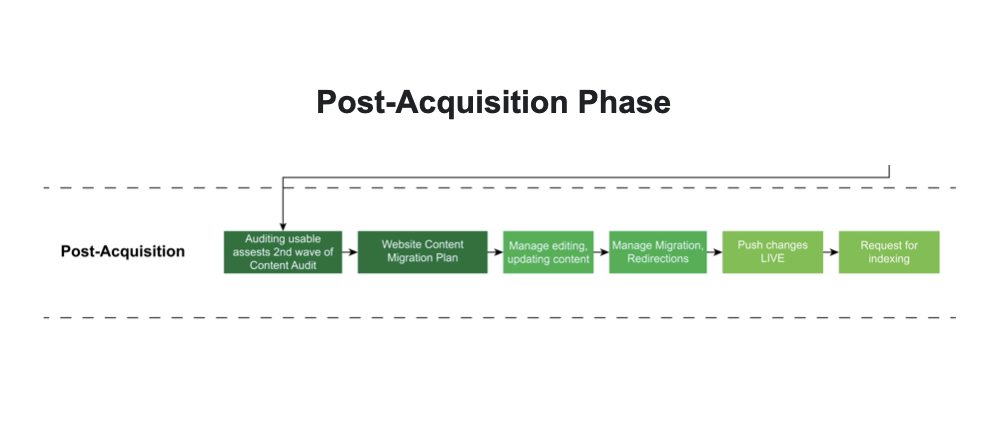
So now that you’ve closed the deal, and you acquired your new website, and managed properly the handover, it’s time to move forward to the last phase of this process, the post acquisition phase.
At this point, the goal is to decide what to do with your content, handle all the editing and technical process.
But let’s see everything in detail.

What you have to do is create a spreadsheet and gather all the URLs of the acquired website. The goal is to label each URL, either as migrate, edit, redirect, or kill.
Then you have to map out any kind of changes on your notes and old vs your new URLs, any updates on the metadata and map out the redirections.
Then it’s time to push changes, submit the new sitemaps and you’re ready to go.
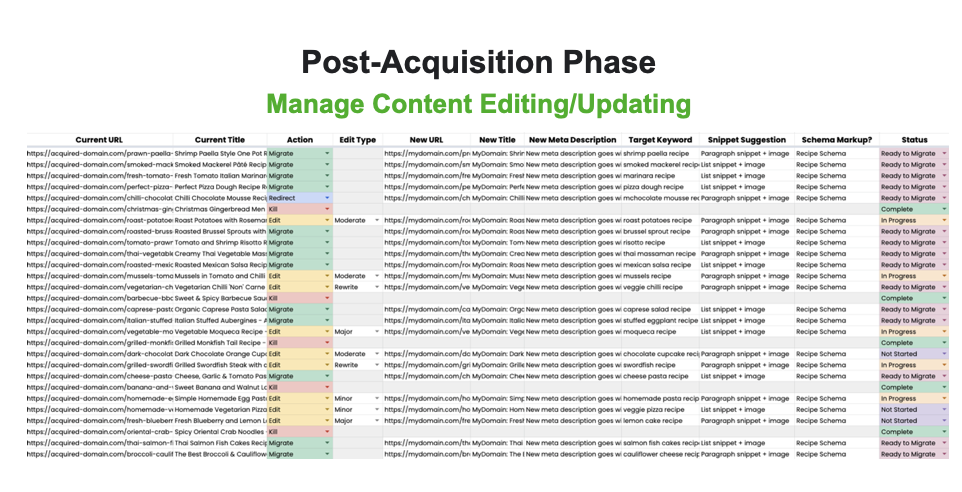
But let’s start with the auditing process. The concept here is simple. You need to label each URL as migrate, update, redirect or kill. In order to do that, you need to gather all the data to evaluate your content.
So, for each URL, you need to gather the following data.
- Number of keywords if any kind of keywords, they are ranking on the top search results
- The potential traffic and the actual traffic
- The backlinks, the number of backlinks for each page
When you have this kind of data, you can now decide what to do with the content.
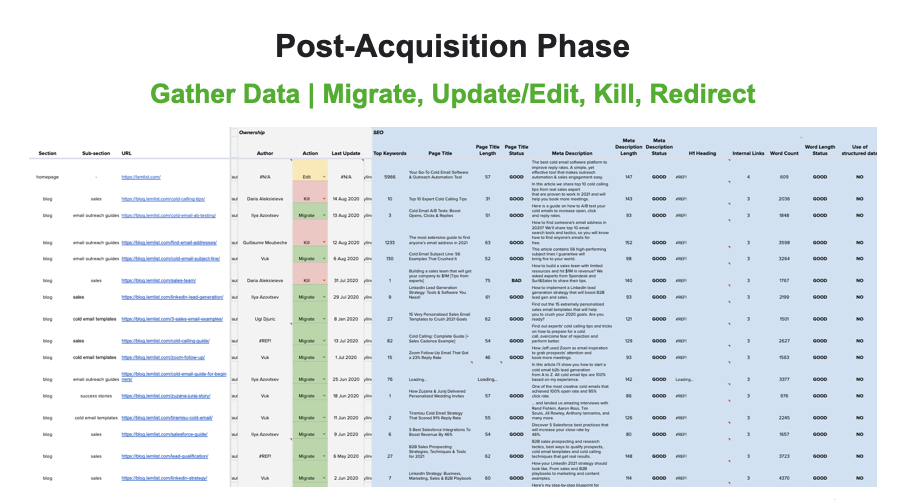
But let’s start with the auditing process. The concept here is simple. You need to label each URL as migrate, update, redirect or kill. In order to do that, you need to gather all the data to evaluate your content.
So, for each URL, you need to gather the following data.
- Number of keywords if any kind of keywords, they are ranking on the top search results
- The potential traffic and the actual traffic
- The backlinks, the number of backlinks for each page
When you have this kind of data, you can now decide what to do with the content.
Once you’ve managed all the content editing and content migration, you’re almost done.
Now you need to submit your Sitemap in order to request re-indexing of the website.
Then you’re ready to go live.
It’s really important to monitor the process and see the traffic changes on your own website and see the results.
Hopefully you will have results within two to three months.
Final Thoughts
Now that we are done with the process.
Let me share with you my top three secrets for website assets acquisition.
1) Try to find domains that requires the minimum of editing, and they have the maximum of ROI in terms of monetization and revenue. Trust me, you will save a tons of time.
2) Evaluate at least five domains before we move forward with a final decision. You have a better picture of what is going on in the market.
3) Don’t just migrate the entire domain or the entire content to your homepage. This is just a waste of money, and you lose all the SEO value of it and the business value of it.
So, this is it. Good luck with the process.

